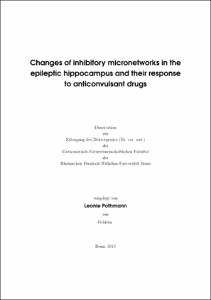Pothmann, Leonie: Changes of inhibitory micronetworks in the epileptic hippocampus and their response to anticonvulsant drugs. - Bonn, 2015. - Dissertation, Rheinische Friedrich-Wilhelms-Universität Bonn.
Online-Ausgabe in bonndoc: https://nbn-resolving.org/urn:nbn:de:hbz:5n-41843
Online-Ausgabe in bonndoc: https://nbn-resolving.org/urn:nbn:de:hbz:5n-41843
@phdthesis{handle:20.500.11811/6555,
urn: https://nbn-resolving.org/urn:nbn:de:hbz:5n-41843,
author = {{Leonie Pothmann}},
title = {Changes of inhibitory micronetworks in the epileptic hippocampus and their response to anticonvulsant drugs},
school = {Rheinische Friedrich-Wilhelms-Universität Bonn},
year = 2015,
month = nov,
note = {With around 50 million people worldwide suffering from chronic epilepsy, it is one of the most common neurological disorders. However, despite extensive research in this area, the actual network mechanisms involved in the generation of seizures are still not fully understood. This lack of insight is especially important given that 30 % of patients still cannot be treated sufficiently with the available antiepileptic drugs. Outstanding alterations in the epileptic brain are the loss of inhibitory interneuron subtypes and a reduction in GABAergic responses. They suggest that the pathological hyperexcitability characteristic of epilepsy is related to a reduction in GABAergic inhibition. However, the role of GABAergic inhibition is far from limited to reducing neuronal excitability: inhibitory interneurons control spike timing of pyramidal cells, synchronize large populations of neurons and play a role in network oscillations that occur during different states of the brain. These different tasks of interneurons suggest that changes in the spatial and temporal profile of surviving interneurons will also strongly influence network. In the first part of my PhD thesis I therefore investigated whether the spatiotemporal profile of feed-back inhibition is changed in chronically epileptic rats using the pilocarpine model of epilepsy. I focused on the CA1 area of the hippocampus because this brain region is strongly affected in temporal lobe epilepsy, a subform of epilepsy with a high incidence of pharmacoresistance. Using electrical activation of inhibitory feed-back microcircuits in acute hippocampal slices, I could show that the spatiotemporal profile of inhibition provided by the surviving interneurons is altered in experimental epilepsy. As a result, the usually strong initial feed-back inhibition onto CA1 pyramidal cells was reduced. These data suggest marked changes in the dynamics of feed-back inhibition in chronic epilepsy that may be relevant for the initiation of seizure activity in the CA1 ensemble.
In the second part of my thesis I investigated the effects of commonly used sodium channel blocking anticonvulsants on inhibitory microcircuits. GABAergic interneurons are able to fire at very high rates and should consequently be affected by these drugs. This however would cause a further reduction of GABAergic inhibition and thus increase excitability. My experiments revealed that, based on intrinsic and circuit properties, under these experimental conditions, both feed-forward and feed-back inhibition are not affected by these drugs, enabling them to fulfill their function. Furthermore, this study shows that the net effect of CNS drugs on the complex neuronal circuitry within the brain cannot be predicted by their action on individual cell types but also critically depends on the interplay of neuronal subtypes within this network.},
url = {https://hdl.handle.net/20.500.11811/6555}
}
urn: https://nbn-resolving.org/urn:nbn:de:hbz:5n-41843,
author = {{Leonie Pothmann}},
title = {Changes of inhibitory micronetworks in the epileptic hippocampus and their response to anticonvulsant drugs},
school = {Rheinische Friedrich-Wilhelms-Universität Bonn},
year = 2015,
month = nov,
note = {With around 50 million people worldwide suffering from chronic epilepsy, it is one of the most common neurological disorders. However, despite extensive research in this area, the actual network mechanisms involved in the generation of seizures are still not fully understood. This lack of insight is especially important given that 30 % of patients still cannot be treated sufficiently with the available antiepileptic drugs. Outstanding alterations in the epileptic brain are the loss of inhibitory interneuron subtypes and a reduction in GABAergic responses. They suggest that the pathological hyperexcitability characteristic of epilepsy is related to a reduction in GABAergic inhibition. However, the role of GABAergic inhibition is far from limited to reducing neuronal excitability: inhibitory interneurons control spike timing of pyramidal cells, synchronize large populations of neurons and play a role in network oscillations that occur during different states of the brain. These different tasks of interneurons suggest that changes in the spatial and temporal profile of surviving interneurons will also strongly influence network. In the first part of my PhD thesis I therefore investigated whether the spatiotemporal profile of feed-back inhibition is changed in chronically epileptic rats using the pilocarpine model of epilepsy. I focused on the CA1 area of the hippocampus because this brain region is strongly affected in temporal lobe epilepsy, a subform of epilepsy with a high incidence of pharmacoresistance. Using electrical activation of inhibitory feed-back microcircuits in acute hippocampal slices, I could show that the spatiotemporal profile of inhibition provided by the surviving interneurons is altered in experimental epilepsy. As a result, the usually strong initial feed-back inhibition onto CA1 pyramidal cells was reduced. These data suggest marked changes in the dynamics of feed-back inhibition in chronic epilepsy that may be relevant for the initiation of seizure activity in the CA1 ensemble.
In the second part of my thesis I investigated the effects of commonly used sodium channel blocking anticonvulsants on inhibitory microcircuits. GABAergic interneurons are able to fire at very high rates and should consequently be affected by these drugs. This however would cause a further reduction of GABAergic inhibition and thus increase excitability. My experiments revealed that, based on intrinsic and circuit properties, under these experimental conditions, both feed-forward and feed-back inhibition are not affected by these drugs, enabling them to fulfill their function. Furthermore, this study shows that the net effect of CNS drugs on the complex neuronal circuitry within the brain cannot be predicted by their action on individual cell types but also critically depends on the interplay of neuronal subtypes within this network.},
url = {https://hdl.handle.net/20.500.11811/6555}
}






